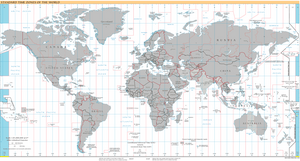UTC−11:00 is an identifier for a time offset from UTC of −11:00. This time is used in Niue, American Samoa, Swains Island, and parts of the United States Minor Outlying Islands.[1] This is the latest inhabited time zone, meaning this is the last inhabited time zone to celebrate the New Year, as the world's latest time zone (UTC-12:00) occurs only in strict nature reserves, such as Howland and Baker Island.
| UTC−11:00 | |
|---|---|
| Time zone | |
 World map with the time zone highlighted | |
| UTC offset | |
| UTC | UTC−11:00 |
| Current time | |
| 06:59, 19 November 2024 UTC−11:00 [refresh] | |
| Central meridian | |
| 165 degrees W | |
| Date-time group | |
| X | |

As standard time (year-round)
editPrincipal settlements: Alofi, Pago Pago, Tafuna
Oceania
editPacific Ocean
editPolynesia
editFormerly within
edit- Kiribati
- Phoenix Islands (of which only Canton Island is inhabited) (Phoenix Islands Time) advanced 24 hours to the eastern hemisphere side of the International Date Line by skipping December 31, 1994.[3]
- New Zealand
- Tokelau – Time in Tokelau advanced 24 hours to the eastern hemisphere side of the International Date Line by skipping December 30, 2011.[4]
- Samoa – Time in Samoa advanced 24 hours to the eastern hemisphere side of the International Date Line by skipping December 30, 2011.[5]
- United States
- Bering Standard Time – Before Alaska Standard Time was adopted across almost all of Alaska (other than the Aleutian Islands, which adopted the Hawaii–Aleutian Time Zone) in 1983, Nome, and the Aleutian Islands were previously in Bering Standard time.[6]
References
edit- ^ UTC-11:00. 24TimeZones.com. Retrieved May 9, 2021.
- ^ "Midway Atoll: Midway Islands". WorldTimeZone. Retrieved 24 July 2012.
- ^ Lane, Megan (10 May 2011) "How does a country change its time zone?". BBC News. Retrieved May 9, 2021.
- ^ "Tokelau to join Samoa and leap forward over dateline". BBC News. October 6, 2011. Archived from the original on 29 October 2012. Retrieved May 9, 2021.
- ^ McCabe, Joanne (May 9, 2011). "Samoa to change time zones and move forward by a day". Metro. Archived from the original on December 28, 2012.
- ^ Turner, Wallace (1 November 1983). "Alaska's four time zones now two". The New York Times. Retrieved 11 October 2022.